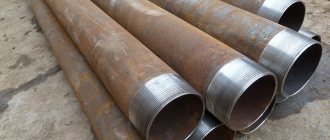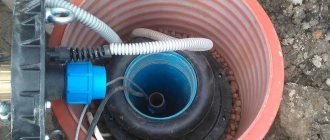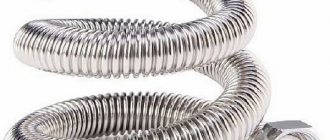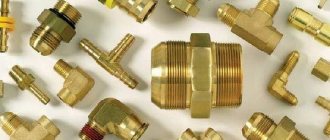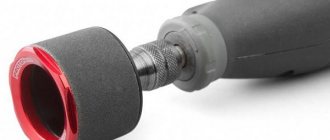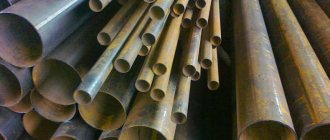Special pipes are used to equip oil wells, supply water to a personal or summer cottage, and also to solve a number of other problems. The requirements that the casing pipe must meet are specified by the state standard. For pipes made of metal, this standard is GOST 632-80.
Casing steel pipes for wells
How to determine the required casing diameter for a well
The dimensions of the well, and, accordingly, its casing, depend on a host of factors.
First, we need to analyze the data we already have about aquifers underground. You can ask your neighbor for such information, but it is best to get it from specialized companies. To calculate the diameter of the casing pipe, you need to analyze the maximum possible water flow. In this case, it is worth considering not only the amount of water required for drinking or cooking, but also for all other household needs, such as keeping animals and watering the garden. Based on this value and the depth of groundwater, you need to select a submersible pump model. When choosing a design, it is worth considering that as the diameter increases, drilling a well using a casing pipe will become much more expensive, so you should not make the cavity excessively large.
Having information about the outer diameter of the submersible equipment, taking into account the double thickness of the pipe walls and the technological gap, the size of the casing pipe is selected. Most often, the nearest standard value is chosen upward. Before purchasing it, you should find out the capabilities of the drilling equipment used in your area; its functionality is often limited.
Pumps offered by manufacturers can be installed in wells of various diameters. The most economically optimal is considered to be a casing pipe for a well with a diameter of 125 millimeters. It is by choosing it that you can achieve an excellent cost ratio between drilling a well and submersible pumping equipment. The use of larger diameter pipes is almost never practiced for domestic water sources.
Types of casing pipes for wells
The specific type of casing communications is selected individually, for each specific site, taking into account:
- well depth,
- soil structure,
- cost of consumables.
It is not always possible to make the bypass pipe one-piece - very often it is necessary to join several sections together. Experts recommend using threaded pipes for wells. Thanks to the threaded connection, the sections are securely fixed to each other. The use of butt or coupling joints is extremely undesirable, since soil can penetrate into the pipe through the joints and cause failure of the submersible pump.
Steel pipe for well
Steel pipes have been used in well drilling for a long time. They are distinguished by their reliability and durability. A steel pipe, the wall thickness of which is about 5 mm, can serve without complaints for more than 40 years. In some cases, drilling wells is only possible using steel products.
The disadvantages of steel casing pipes should also be noted. The metal is constantly in contact with water, which leads to its gradual corrosion. As a result of this natural process, the incoming water may contain rust impurities. Although, in principle, this problem can be solved by installing a water filter. Another disadvantage is the high cost. This is especially noticeable recently, due to the rise in price of metal products.
Asbestos cement casing pipes
Asbestos cement pipes are also very common for well construction. Their popularity is due to their low cost and availability. The service life of such pipes is more than 60 years.
To be fair, the disadvantages of asbestos-cement pipes should also be listed. First of all, it is heavy weight and thick walls. To install such pipes, it is necessary to use larger diameter drills and lifting equipment. This leads to an increase in the cost of the well. Also, the installation of such products should be carried out by organizations specializing in this, since the joining of pipe sections to each other has a number of features.
During installation, it is necessary to exclude the possibility of gaps appearing at the joints. Not all specialists can perform such work efficiently, because the structure has butt joints. Some sources contain information that asbestos fibers contain a dangerous element - chrysotile, which over time can lead to deterioration in the health of people using water from such a well. However, the effect of asbestos-cement products on humans has not been fully elucidated.
Plastic casing products
The most modern material for wells is plastic. Plastic pipes for wells are lightweight compared to steel or asbestos-cement pipes. Moreover, their price is not that unaffordable compared to metal. Simple installation and high tightness of connections allow us to conclude that plastic pipes are now the main material used for drilling wells.
A polyethylene pipe for a well can be used for more than 50 years. Plastic is resistant to corrosion and neutral when interacting with aggressive chemicals. Deposits do not form on the walls of plastic pipes, and repair of plastic products is an extremely rare need.
PVC pipes for wells can be of two main types:
- uPVC,
- HDPE.
Plastic pipes for HDPE wells are low-pressure polyethylene products. They are easy to install and environmentally friendly. Like all plastic pipes, they are not afraid of internal deposits and are capable of bending if necessary, taking a given shape.
Therefore, builders try not to install HDPE pipes in wells, recommending the installation of PVC-U pipes. Although HDPE products are quite suitable for laying sewers, gas pipelines and water pipes. HDPE pipes do not have a threaded connection, but are joined together with a flange or coupling connection.
UPVC plastic pipes are made from unplasticized PVC. The material is highly durable. In terms of strength, uPVC pipes can be compared with their steel counterparts.
UPVC products have a higher permissible stress, yield strength and density compared to HDPE.
For example, a PVC-U pipe with a diameter of 125 mm, when submerged to a depth of 30 meters, can withstand a load of more than 5 tons. Such products can be installed in almost any soil. PVC-U pipes differ from HDPE pipes in the presence of a threaded connection.
Only after carefully studying the types of casing pipes, make a decision on the choice of a specific material
Take your capabilities and needs into account
Peak water demand
This indicator is required when drilling wells on a plot of land adjacent to a dacha or country house. It is taken into account that the flow rate of a tap that is fully open is about 0.7 cubic meters of water per hour.
If we assume that at the same time it will be needed for a washing machine and watering the area, in the kitchen, in the bathroom, then its consumption during the period of peak consumption will be 2.5-3 cubic meters per hour. If the building is two-story, then it will be necessary - 4-8 cubic meters / hour.
What type of products to choose
If you need a well casing, it can be made from various types of pipes:
- asbestos-cement;
- plastic;
- steel, etc.
They are distinguished not only by price, but also by performance characteristics. Below is a detailed description of each type of product.
Asbestos cement pipes
This type of materials has been successfully used for many years, since they are characterized by the following positive qualities:
- neutrality;
- resistance to corrosion;
- resistance to chemicals.
Pipe in a well
However, in addition to the positive properties, there are also negative ones, which led to a decline in the popularity of this material:
- high requirements for tightness and neatness of joints;
- impossibility of installation in sandy soil;
- the impossibility of equipping wells whose depth exceeds one hundred meters;
- high price of material.
Steel pipes
These models have increased resistance to virtually any load.
However, this positive characteristic is offset by negative ones:
- susceptibility to corrosion;
- high iron content in water;
- the need to install a filter to combat iron and rust;
- the likelihood of pump failure as a result of rust getting into it;
- metallic taste of water;
- difficulty of installation.
Steel models
Note that the installation of a casing pipe in a well in this case is carried out only on two types of soil:
- sandy;
- limestone
Plastic models
This type is considered the most optimal today because:
- reliable;
- easy to install;
- durable;
- inexpensive.
However, if you are interested in how to install a casing pipe in a well if a plastic product is selected, then please note that they are only suitable for shallow sources
Plastic product with thread
The following types of products are most often used for installation:
- from unplasticized polyvinyl chloride;
- polypropylene;
- polyethylene.
uPVC casing pipes
Connection types
When arranging the casing, pipes are connected into a column in the following ways:
Socket threaded . The method is used when joining polymer or metal thin-walled pipes, while an internal thread is cut in the socket, and an external thread is cut in the section of the outer shell of the connected pipe.
Threaded. They are used in thick-walled metal and polymer pipes; the connected elements have external and internal threads; when they are joined, the walls are smooth on the outside and inside.
Coupling. The pipe elements to be connected have an external thread; they are screwed into a connecting coupling with an internal thread until the ends are connected.
Electric welding. Welding can be useful when joining thin-walled steel pipes where the cut threads would be too weak. The welding method is often used when installing steel casing - although it takes some time and requires good welding skills from a specialist, its use can be cost-effective (no need to purchase expensive heavy pipes with threads and thick walls).
Rice. 13 Steel and HDPE casing pipes
Types of casing pipes for wells
Each of them has a number of advantages and disadvantages, which determines their intended purpose. If it is not clear which pipes are best for wells of a particular depth, read on or contact a specialist.
Metal pipes
There is another classification here. Products are divided into types, and they are:
- cast iron or steel;
- enameled;
- galvanized;
- made of stainless steel.
It is impossible to say unequivocally which casing pipe for a well is better, because each type is used depending on the climate, soil characteristics, depth of aquifers, and other factors.
The most popular type of metal casing pipes are steel. Steel is applicable for the construction of artesian wells when the depth reaches the level of occurrence of limestone aquifers. Don't know which pipe to choose for your well? Steel is a universal material that is suitable for any type of source and purpose. The advantages are:
- Long period of operation.
- High load-bearing capacity with small dimensions.
- Immunity to external mechanical influences and deformations.
- Abrasion resistance, ability to clean the source from bottom sediments.
You will have to pay for all the listed requirements for casing pipes. High cost and heavy weight - these are minutes of metal casing for wells. During use, the water develops a metallic taste. It is difficult to install a pit yourself due to the high specific gravity.
Asbestos cement pipes
This is a material whose cost is lower. It is resistant to salts. Asbestos cement has been used for many years in the construction of hydraulic structures. The list of main advantages is as follows:
- The appearance of corrosion spots is excluded.
- The permissible operational period is 65 years.
- The price is affordable, always on sale.
But there are a number of disadvantages, and the first of them is that such casing pipes should not be used for constructing an artesian well. Besides:
- Difficult installation, the need to use special equipment.
- The material is fragile and is susceptible to mechanical shock, which complicates transportation.
- A flange connection or joint-to-joint joint is provided, which does not guarantee tightness.
- Regular maintenance required. A coating appears on the surface that will have to be removed.
The diameter of the well casing pipe and the wall thickness vary, but the range presented has a smaller range of applications than metal or plastic.
Plastic pipes
ND polyethylene, PVC and polypropylene continue to squeeze metal and concrete competitors out of the market. The popularity was ensured by competitive advantages, of which there are many:
- Extended service life.
- Absolute inertness towards salts and other chemical elements.
- The appearance of foci of corrosion and rotting is excluded.
- Low specific gravity allows you to carry out work without construction equipment.
- A threaded connection is provided to ensure absolute tightness.
- Easy to transport, store and use due to its low weight.
To understand which pipe is best to use for a well, if your budget is limited, add low cost to this list. The disadvantage is the limitation on the depth of the well, which cannot exceed 60 meters. Otherwise, everything depends on the selected wall thickness and section geometry.
Calculation of the diameter of the pipe for casing the well
When calculating the planned flow rate, we must not forget that it directly depends on the diameter of the casing pipes. In other words, the water supply is greater in that source; the project provides for a larger diameter of pipes for the water well.
But this is not the only factor influencing the choice. The parameters of the pumping equipment that are planned to be installed are taken into account. On average, to pump 4 cubic meters of water, you will need a pump with a body diameter of about 8 cm. There should be a reserve of 5 mm on each side.
This is the distance from the pump to the inner surface of the casing. Therefore, in this case, you need to add 2 times 5 mm to 80 mm. It turns out that to achieve this task, you will need a casing pipe with a diameter of 100 mm.
Which column assembly option is better?
A set of requirements for casing pipes and technologies for connecting well string segments is reflected in GOST 632-80.
The regulations allow the use of different assembly methods. Based on the joining method, the appropriate type of pipe is selected, so this issue must be resolved at the well design stage.
No. 1 - permanent contact of pipes for welding
Welding provides the most rigid connection of metal pipes. The main advantage of the method is now being questioned by representatives of a number of drilling companies.
Arguments against using welding:
- the likelihood of insufficient sealing of the weld;
- the possibility of pipe deflection along the vertical axis, which makes it difficult to install the column in the well;
- insufficient corrosion protection of the seam.
However, with a high level of professionalism of the welder, the listed defects will not occur. Most building structures (bridges, trusses, oil pipelines) are made of steel and, as a rule, they are welded.
Another issue is that high-quality work requires welding equipment and the involvement of a qualified electric welder. These measures increase the cost of work performed, reducing the profit and competitiveness of the performing organization.
Welding electrodes use a protective coating, which ensures alloying of the weld seam. This increases the strength of the metal and increases the corrosion resistance of the joint.
No. 2 - water-lifting channels with threads
When casing a well with rolled metal, 90% of drilling companies use a threaded connection, pointing to GOST standards. It sounds quite convincing, but managers of organizations often keep silent that the standards are relevant for pipes with a diameter of 146 mm and a wall thickness of at least 6 mm.
The use of threaded technology significantly reduces the service life of the casing.
In a 4.5 mm thick pipe, the thread size does not always reach 1.2-1.5 mm. Knowing the rate of corrosion (0.1 mm/year), we can assume that in 12-15 years the pipe will rot at the junction
The use of a threaded connection on plastic lines does not have such disastrous consequences, but, on the contrary, is considered the most reliable.
There are several options for joining polymer pipes:
- Nipple. The thread is cut from the inside of plastic pipes. The two elements are connected through a nipple with an external thread. The diameter of the hole does not increase.
- Coupling. There is an external thread at both ends of the pipe. Docking occurs using an overhead coupling, which increases the diameter of the penetration.
- Socket threaded. Segments with threads on the outer and inner surfaces are used - joining is carried out without additional elements.
With socket joints, a slight expansion of the diameter at the joints is permissible.
The socket method of joining without threads is not used in wells - it is impossible to control the process of installing the pipe into the pipe. In addition, the connection does not provide the necessary tightness of the column and causes subsidence over time.
Types of casing pipes
Modern industry produces the following types of casing pipes:
metal. It is these products that have found the greatest application as casing pipes. Metal pipes ensure the safety of the water source due to the fact that they can easily withstand small movements of the soil.
But we cannot ignore one significant disadvantage of steel casing - susceptibility to corrosion. As a result, after a short period of time, rust flakes from the inner surface will begin to enter the water, causing its quality to significantly decrease. There are two ways to combat this phenomenon: the initial installation of stainless steel casing and the use of filters
But, since the cost of stainless steel is rather high, this option will be very expensive for the customer.
asbestos-cement. Pipe products made from this material also have a number of advantages. For example, homeowners are attracted by the long service life and low price of products. But asbestos-cement casing pipes can only be used to a depth of 15 meters, since with a higher value of this parameter, the pressure exerted by the soil can cause the destruction of this fragile material. And the cost of work increases the need to drill a channel with a large diameter due to the significant thickness of the walls of pipe products of this type. And you should also remember about the dangers of asbestos to human health.
If we compare plastic pipes with metal and asbestos-cement analogues, we can highlight their following advantages:
- not susceptible to corrosion;
- the aging process of the material does not cause hazardous chemical compounds to enter the water;
- limescale does not form on the walls of polymer pipes;
- physical and chemical properties ensure a long service life;
- compared to other materials, the connection of plastic casing elements provides better tightness;
- the cost of polymer pipes is lower than that of existing analogues.
Despite the popularity of polymer pipes, only steel casings are used for wells operating in difficult conditions
Among the disadvantages of such pipe products is their inability to withstand heavy loads. Therefore, drilling technology with a plastic casing pipe is aimed at creating a well up to 50 meters deep. The diameter of the pipe product is of great importance, and it must be selected as accurately as possible, since the potential water flow rate, as well as the possible drilling depth, depends on this.
Which material is better?
The market is filled with a variety of pipes made from steel and plastic. The following is their comparative characteristics.
Steel: pros and cons
Steel pipes are made from ordinary steel, less often from stainless steel, with galvanized or enamel coating. They have the following advantages:
- mechanical strength - a product with a 6-mm wall can easily withstand any soil displacement and allows you to clean the well without fear of possible damage;
- tightness - individual pipes are welded together, which prevents the penetration of water from the upper layers;
- good maintainability;
- resistance to rust with proper sealing
of the pipe outlet with the head - “there is not enough oxygen in the water for the pipe inside to rust”; - durability - service life is at least 50 years, which is confirmed by real facts.
The disadvantage of stainless steel products is their high cost. Enameled pipes chip during installation, which can lead to rapid corrosion in the future. Galvanized pipes are cheaper, but when interacting with water, zinc oxide is formed - it is believed that it is hazardous to health.
The disadvantages of iron pipes, according to organizations that use PVC pipes, include: the susceptibility of iron to chemical reactions, corrosion instability, short service life (supposedly no more than 10 years), high weight, less hygiene compared to PVC.
Fastening wells during drilling
- Well performance;
- Well lifespan;
- The strength and tightness of the channel through which the extracted product will flow from the horizon to the surface;
- Protection of the operating channel from corrosion;
- The strength of the well walls in places where the rocks are not stable enough;
- Tightness of separation of all permeable horizons from each other.
Securing oil wells involves the use of special columns or packers. The use of columns is the most popular method, which allows you to make the well strong, durable, and also isolate permeable horizons. Such columns are made up of special pipes called casing.
Dependence of the diameter of the service pipe on the dimensions of the pump ↑
The diameter of a water well directly depends on the type and size of the pump, and vice versa, the choice of pumping equipment is carried out in accordance with the dimensions of the casing.
If the water surface is located close to the surface, then for water intake you can use self-priming surface pumps, which often come complete with hydraulic accumulators and are called pumping stations.
When using a pumping station, the diameter of the water well depends on the diameter of the water-lifting pipe or hose that goes down. As a rule, in this case, a 50 mm casing is sufficient to ensure normal operation of the water supply system.
The minimum diameter of deep well pumps is 3 inches (76 mm). Installation of such devices can be carried out already in a 90-mm casing pipe. However, for domestic needs, in most cases, 4-inch units are used, which are cheaper and have higher performance. For their normal placement, a production string of at least 110 mm is used.
The distance between the body and the casing wall should not be less than 2 mm along the entire radius. At the same time, for vibrating submersible pumps this criterion is more stringent, since direct contact with the production casing may cause structural failure.
To accurately determine the diameter of the pipe for a well pump, you can use a simple formula:
D(casing) = D(pump) + clearance + wall thickness
Thus, for a 3-inch unit, the minimum diametrical hole size will be:
D = 76 + 4 + 5 = 85mm
Based on this, a column of 90, 113 or 125 millimeters is suitable for such devices (in accordance with the table above).
For submersible well pumps with a diameter of 4 inches (102 mm), the permissible casing size will accordingly be different:
D = 102 + 4 + 5 = 111 mm
Using the table, we select the required dimensions: 113, 125 or 140 millimeters.
On the one hand, a small-diameter well is difficult to maintain and tends to silt up quickly; on the other hand, drilling and equipping wells that are too large is financially unprofitable. Sometimes it is very difficult to find the most rational solution on your own. In this case, it would not be a bad idea to take the help of specialists.
Carrying out the necessary calculations
The productivity of the well on the land plot will depend on how correctly the diameter of the pipes is selected. The larger the cross-section of the pipes, the greater the volume of water that can be pumped out.
To reduce the cost of purchasing casing pipes for drilling and well operation, you must first calculate the smallest diameter size that can satisfy the need for water resources. To do this you will need to make some calculations.
Types of pipes and selection criteria
Plastic casing pipes
Casing pipes are divided into several types depending on the material of manufacture:
- plastic (PVC, uPVC);
- metal;
- asbestos-cement.
Each material has a certain service life and also affects the quality of well water. To decide on the choice of material, you need to study the features of each in more detail.
Metal mines
Steel is used quite often to strengthen the casing channel, especially in artesian wells characterized by great depth. Steel products are strong and reliable; if properly installed and maintained, they can last for several decades. Well casing made from sewer steel pipe is a common occurrence.
The movement of soil layers has a negative impact on the structure. The material is also susceptible to corrosion, causing the quality of well water to deteriorate. To avoid such a problem, you need to give preference to stainless steel, but the costs of constructing a well will increase significantly.
Asbestos-cement structures
Long service life and excellent characteristics are characteristic of asbestos-cement products. However, there is a fairly extensive list of disadvantages:
- Insufficient strength at great depths, where the pressure of soil layers reaches critical levels.
- Asbestos, despite the fact that it is in a bound state with cement, over time can begin to decompose into components that have a negative impact on the quality and taste of water.
- Due to the large thickness of the walls of the casing rings, the diameter of the well needs to be drilled larger, which negatively affects the cost of work.
Well casing with plastic pipes is becoming increasingly common. This is due to the fact that products made from low-density polyethylene or polyvinyl chloride have excellent qualities that are used in various communications.
- Compared to previous analogues, the cost of products is significantly lower.
- The material is not afraid of corrosion, and no plaque forms on its surface.
- The products do not decompose and do not have a negative impact on water quality.
- Thanks to high strength and reliability, a long service life is ensured.
- The use of modern methods of connecting parts ensures the tightness of the channel.
- Due to its low weight, the casing is easier to install.
Is a well conductor really needed - in what cases?
A conductor may be required in areas with loose soils and deep cracks, but I advise you to be careful if drillers insist on using it - for the Moscow region this measure can be considered an extreme measure.
First, I will explain what a well conductor is. Essentially, it is a pipe of larger diameter compared to the casing itself. Its use is not always necessary - sometimes drillers recommend its use in order to earn more, because the price of one linear meter of drilling in a section with a conductor increases by about 1300-1500 rubles.
But sometimes you really can’t do without it - however, this becomes clear in 90% of cases after the drilling has started.
Construction of a well with a conductor.
The use of a conductor in the Moscow region is necessary when the upper soils are loose or have deep cracks.
Drilling is carried out by supplying an aqueous solution to the drill head, and if there is a crack in a section of the wellbore, the solution begins to leak out, but dry drilling cannot be done. In this case, the conductor will indeed be the only way to continue work and reach the specified depth.
IMPORTANT
The conductor does not need to be driven to the entire depth of the well - it is enough to go through the problem area in the upper layers of the soil, after which drilling continues without it. Additional payment is made according to the footage of the additional pipe. The space between the conductor and the column must be sealed with concrete pouring.
Well casing device
There are only three main units that are included in the casing complex:
- Bottom filter. Prevents sand and clay from entering the pump, leaving it clean and operational.
- Fine filter. Purifies water from small inclusions, making it suitable for domestic use.
- Header. A kind of sealed casing cover that has holes for connecting pipelines and laying power cables.
The casing walls themselves can be metal, plastic or asbestos-cement at the request of the customer. The only limitations can be the technological features of the site and the qualitative composition of the soil cut.
Don't forget about the meaning of the destination and source type:
- Abyssinian well for irrigation. Concrete pipes are suitable, as their cost is completely justified.
- Sand well. Plastic is suitable, since the depth of such a well is no more than 90 meters.
- Artesian spring. Metal pipes. Artesian water is located at a depth of 100-350 meters.
???????? ??? ??????:
???? ?? ?? ???? ???? ?????, ??????????? ???, ?? ??????? ?????????????? ??????
???????? ?????
?????? :
?????????? ?????????
??????????????? ????: — ???. ?????! ?? ???????????? ???????? ??????? ????? ?? «?? ???????? ?????» ? ???? ??????
????????? ?????? ? ???????? ???? ???? ??????????? — +7
Construction of a water well
Comparison of caissons
Well cleaning with pump
Definition and purpose of casing
This is an important element of a hydraulic structure, since it is installed in the very center of the structure. Thanks to the pipe, the possibility of soil collapse is eliminated, which may be a consequence of its low density and mobility of soil layers. For this reason, only the strongest casing should be selected. The space between this structural element of the hydraulic structure and the ground is filled with concrete.
Another purpose of casing is to prevent disruption of the pumping equipment that is lowered into the well. At the same time, there is a risk of contamination of its main components when pumping liquid containing large fractions.
Additionally, it is noted that it is possible to prevent the penetration of groundwater into the well. Thanks to the protective casing, the rate of siltation of the hydraulic structure is significantly reduced. As a result, the service life of the well increases.
The pipe is a product with a reinforced casing, which is made from durable materials. Depending on the depth of the well, the type of structure is determined: solid, assembled from several products.
The first option is more preferable, but it is not always possible to install a pipe of significant length. When the well depth is large, it is recommended to consider the option of installing a prefabricated structure. It must be sealed, which will eliminate the risk of water getting between the concrete layer and the outer wall of the pipe. As a result, the protective layer can be destroyed by water due to leakage under pressure.
If you plan to use water from a well for irrigation, it is enough to install only 1 casing. It will serve as a pipe through which water rises from the pumping equipment into the water supply system. If you plan to use water from the well for drinking, then another one is installed inside the reinforced pipe. It should differ in size.
Casing requirements:
tightness of seam connections when installing a prefabricated structure, and it is recommended to choose a threaded method of connecting pipes; long-term operation, the use of products made of durable material (for example, steel) helps to increase the service life; the column must be located in a vertical plane, it is important to maintain the straightness of the structure; absence of toxic substances in the casing material: it cannot be allowed to affect the quality of water lifted from the well;
corrosion resistance, because
the column is in constant contact with the liquid.
